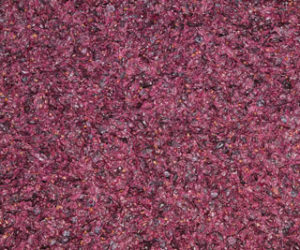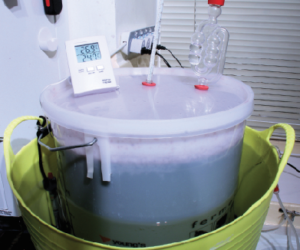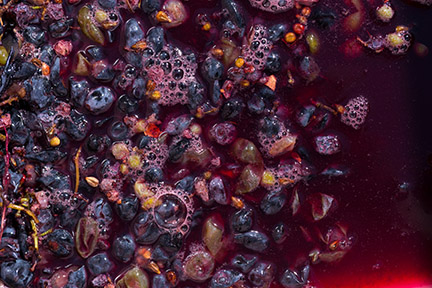
When I was assigned the story detailing the decisions that come up during red wine fermentations, I began to block out the options and decision trees that occur before, during, and after fermentation.
As I finished the decisions that I considered important, I realized that suggesting best practices was very difficult from a single voice in the wine industry. These decisions are personal, and many of them will impact style, flavor, aroma; in other words, I may have to admit that there are no “right” answers. There are only right answers for you, and you will not know what they are until you are educated and experienced. I can’t help with your own experience in your vineyard and winery, but I can invite you into my world, and that of winemaker and “Advanced Winemaking” columnist’s Alex Russan, and see what we can teach you from our successes and mistakes.
I first asked Alex if he had 30–45 minutes for a phone call to debate some of these practices that we will detail in this article. But in a COVID-19 world of pivoting and exploiting media, I came up with another idea. Let’s do a Zoom conference and let the WineMaker readership enjoy it. So, this may be the first WineMaker magazine article that comes with an accompanying one-hour Webinar on red wine decision-making.
Certainly I don’t have enough words here to include every practice, every nuance, every result, but I can summarize efficiently to provide a reference for your future decision-making in the vineyard and the winery. And if you’d like to view the entire conversation Alex and I had, the link is at the end of this article. Now, let’s get into some of the hot topics we debated:
Harvest Chemistry: (A measure of sugar, flavor, and acidity to decide when to pick.)
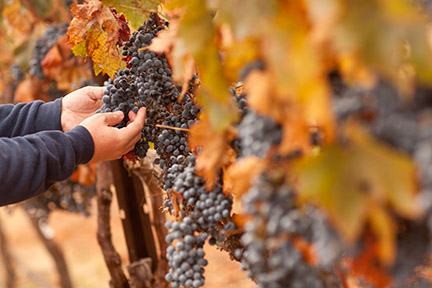
Argument for early harvest or moderate ripeness:
Let’s define the early harvest window as under 23 °Brix for red wine. If picking for pH we will say under 3.4 pH would be considered an early harvest. Alex argues that long hang time can weaken complexity and encourage overt jamminess. Alex doesn’t enjoy overtly ripe wines, and doesn’t want to make them. This style seems to resonate with wine geeks, sommeliers, and some folks with a more European palate. These wines are structured, elegant, and tend to be long-lived and might require patience for completeness.
Argument for elevated ripeness:
Why would we give up ripeness and sunshine? If sunshine is the currency of ripeness, then why not make a wine that represents the full ripeness that the New World can give if you are making wines in an area that is sunny with good summer and fall weather? High ripeness can also be “fixed” in the winery with bottled water and tartaric acid. These full force wines tend to appeal to wine critics, magazines, collectors, and people who like to see the label of what they are drinking at a restaurant. These wines are plush, soft, performative and persistent. One more thing to consider — picking a bit late in someone else’s vineyard may get you a better level of ripeness, as growers sometimes overestimate Brix levels.
Night Harvest: (To pick your grapes at night or in the morning?)
Argument for Day Harvest:
Day harvest allows us to see the fruit and the clusters that may be missed on a night pick. Choosing and sorting fruit is much easier in daylight. Proper layering of clothing and face protection is necessary, especially in warm areas. Picking as early in the morning as possible is beneficial, and choosing a foggy morning can be a good strategy. If you are interested in quick fermentation by feral yeast and allowing your vineyard biome to bloom in your wine, day harvest would help those goals. pH also tends to bump up in the warmest part of the day, so if you want higher pH, warm fruit may make that happen. It is also easier to get labor for day picks, and is safer for the crew. It is unhealthy to change our sleep patterns for weeks or a month of harvest (admittedly, most home winemakers aren’t going to need that much time to pick their backyard vines).
Argument for Night Harvest:
Cool fruit and controlling microbial populations in wine is the main reason we would pick at night. Night picking requires specialized equipment — head lights and perhaps larger lights to illuminate the vineyard and the fruit zone. Once a picker has picked at night, they usually prefer it — it’s comfortable and the time seems to go much faster. Bringing in cool, fresh, sound fruit from a night harvest and seeing it processed will be the main reason a winemaker will prefer night harvest, it arguably does produce cleaner wines from a microbial perspective. Also, in commercial situations, night harvest can deliver an entire harvest just as the winemakers arrive at the winery at dawn.
Destem: (Remove stems and ferment grapes only, or allow stems to be in the must?)
Argument for whole cluster fermentation:
Destemming is a stylistic decision. Whole cluster fermentations are done by leaving the stems in the fermentation for differing tannin building blocks and various polymer sizes of tannin, but the wine will lose a touch of color and acid (pH shifts up). This practice adds complexity in young wines. Alex is toying with 20% of the grapes in his red wine left with stems for his ferments. He finds the aromas nuanced and complexity increased. Philosophically, Alex loves the aromatic compounds and precursors that all of the cluster can give in a good vintage for stem lignification. Tasting and evaluating stems for ripeness/lignification can also be helpful, avoiding the greenest stems, or even “baking” the stems in the sun for a few days can give them less
green flavor.
Argument against whole cluster fermentation:
Wes thinks stems are compost at best, trash at worst. The flavor of stems does not jibe, in his palate, with the flavor of great sites for red wine. He asks the question, “What is the fundamental deficit in this wine/vineyard that requires stem inclusion for balance/deliciousness?” Emile Peynaud, his wine hero, railed against stem inclusion in Burgundy, and Wes agrees. Stems are not terroir, but rather can obscure it.
Cold Soak: (Start fermentation right away, or allow cold must to sit a few days before pitching yeast.)
Argument for cold soaking:
Color is extracted in the first five days, whether it’s cold or not, but that said, traditionally cold maceration is done to increase color extraction and aromas. You could do a cold soak to have softer tannins from a shorter primary fermentation, and extracting color pre-ferment. Even though the science has not been decided on cold soaking, many commercial winemakers seem to use it because that’s how they were taught to make red wine. You will also have time to pause and consider the chemistry of the juice, make a plan, and be more deliberate in your winemaking.
Argument for immediate inoculation with yeast:
There is nothing in wine literature, research, or science that shows cold soaking has any significant impact on red wine fermentation. The evidence is anecdotal and Wes argues most cold soaking is done out of slightly lazy winemaking. After all that effort bringing the fruit in, crushing, cleaning up — why would you want to add on all the time to mix nutrients and yeast and make sure the wines are inoculated? Bringing the fruit into the winery and firing up the fermentation is a great way to only have to clean the winery once, it produces the same amount of color and aroma according to studies, and will get you from juice to wine faster!
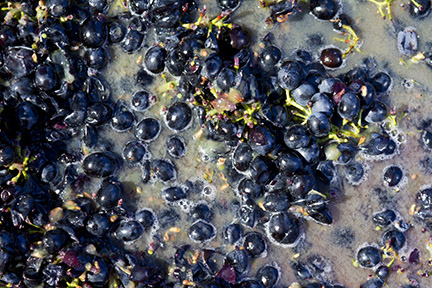
Feral/Native Yeast: (Use commercial yeast or allow the yeast on the grapes to do the work.)
Argument for native/feral yeast:
Arguably, if wine is made in the vineyard and we care about the flavors of place, feral/native yeast will give your wines true uniqueness. You won’t need to pay for yeast and it’s a great story to tell — that no yeast was added. It can be a bit risky, and certainly there are vineyards and wineries that contain yeasts that make terrible fermentation kinetics and flavors. You have to take a chance for a vintage to see how the feral yeasts react and if they make wine you love. Alex likes the complexity and nuance of feral yeast ferments and the authenticity of the microbial life of a vineyard. There is a caveat: This argument only holds true if the vineyard site or the winery produces great feral yeast for spontaneous ferments. The understanding of microbial terroir is a nascent science and should be explored.
Argument for commercial yeast strains:
It’s less risky to use a proven, commercial yeast strain that allows us to control for aroma, alcohol conversion, color, and even flavor. Stunning the red wine must with 50–65 ppm SO2 will reset the microbial state of the wine to a more sterile level, and then when a commercial yeast is added the must will only have one yeast and very few competitive microbes. If a wine has to be commercially viable and show consistency in the market, commercial yeasts give us the ability to guide style, quality, fermentation kinetics, and other aspects of control.
Extended Maceration: (Allowing the red wine to stay on the skins beyond primary fermentation.)
Argument for 2-week maximum maceration:
Pressing the wine off at dryness, or within two weeks from the beginning of fermentation, reduces the amount of volatile acidity/ethyl acetate and the development of acetic acid (vinegar). Leaving a wine in macerated state after “cap fall” (when the skins no longer are lifted by CO2production, and fall to the bottom of the fermenter) is a risky proposition for not a lot of benefit, in Wes’ perspective. Alex says at 21 days, there is no evidence of extraction in red wine ferments. He believes how the wine tastes during extended maceration may make people think it has more of an impact, as the wine may show better with more oxygen.
Argument for extended maceration:
Wineries like Opus One and even some First Growth Bordeaux red wines costing thousands of dollars, are made using extended maceration in warm cellars. The wines finish both primary and secondary fermentation on the skins, sometimes soaking as long as 30–45 days. The argument is that tannin polymerization happens in the extended maceration, making a softer more approachable wine on release. Wes doesn’t use extended maceration, but finds some wines that use it to be fascinating.
Pressing Off at 1–3 °Brix: (How dry should red wine be before pressing it off the skins?)
Argument for pressing off dry:
Alex likes to press dry, and Wes generally agrees. Leaving residual sugar in the barrel can feed microbes and cause problems with Brettanomyces or other microbial issues. Pressing dry allows the wine to be fruity and balanced, and not too jammy.
Argument for pressing slightly sweet:
Many Australians and some New World winemakers argue for pressing a red wine while it still has a few dozen grams of residual sugar per liter (2–3 °Brix). The belief is that more jammy and forward fruit character is preserved pressing early, and the wine will finish fermentation in the barrel, so don’t fill the barrels completely until no more gas is being produced that will protect the wine with headspace. There is an intermediate ground here where you can press before dryness right back into a tank to finish primary. Why go right to barrels with the mess and potential for microbial issues?
Press Fractions: (Keeping wine from various pressing pressures separate.)
Argument for separating press fractions:
The more pressure applied to grapes during pressing results in more astringency being extracted from seed tannins. Separating wine by various levels of pressure on a red wine pressing will guarantee that if the wine becomes bitter or problematic at high press pressure, the winemaker can decide whether to keep or discard the wine before it is blended.
Argument for integrating press fractions into one wine:
If you’re using careful pressing techniques, or you’re an old salt that knows your equipment, you know how much to press the wine so you can fill your barrel all the way up. Getting a little extra wine to fill up your vessel is important, and every drop is precious! Plus, 90% of the wine will always be juicy and easy to press, and it will carry the high press fractions by overwhelming any slightly harsh tannins or loss of acidity. (The harder you press, the higher your pH will rise).
Press the Must Twice/Really Hard: (How hard to press your wine and how many times?)
Argument for hard pressing:
The biggest benefit is the obvious one — more wine. One might not be able to press too hard with a manual basket press, we suggest a hydraulic ram or a bladder press to achieve higher pressure. Emptying the press, mixing the must, and pressing again will get you a higher yield, but you may be breaking some seeds and increasing the pH of the wine as a result (see previous debate on keeping press fractions).
Argument for light pressing:
Less wine, but arguably of a better quality. Most winemakers would agree that free run and light press wine is of higher quality, and giving up those last precious drops of wine in your must can improve the quality of the final product. I argue that red wine should be pressed somewhat lighter than white grapes, as the must gives up more wine that the sweet juice, and in a basket press, I suggest at least two pressing cycles with white grapes to try to get a decent yield.
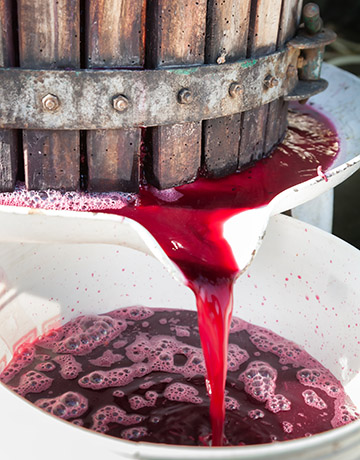
New Oak: (How will new oak impact my red wine as it ages?)
Argument for new oak:
New oak barrels have so many benefits in aging red wine, which is the reason that almost all quality red wines in the world are aged for six months or more in barrel or on staves, chips, or other oak products. Barrels allow for micro-oxidation of the wine during aging, adding small amounts of oxygen by what moves through the pores of the oak and the gases already in the oak. The toast on the barrel adds roasty, spicy, meaty flavors to the wine. More toast generally means more flavor and that the barrel won’t continue to add as much flavor to subsequent vintages. Most red wine drinkers love the flavor of oak and seek out wines that they can identify as being treated with oak during aging. It is also very easy to use new oak to cover up little mistakes in farming and winemaking.
Argument for neutral oak/neutral vessels/concrete/steel/glass:
Neutral vessels suffer no fools. If you are going to make wine in steel, glass, plastic, or concrete, you better bring your A game. New oak can be a Band-Aid for little faults, and glass or steel can make them far more obvious as the wine ages in a reductive environment (no oxygen). Proper care and observation of volatile acidity (VA) levels, fermentation kinetics, temperature, and dissolved oxygen are vital in a commercial winery when you are using steel, glass, etc. Neutral oak barrels give you the best of both worlds, a little bit of oxygen (not as much as new barrels as the barrel crusts over with tartaric acid on the interior), a tiny bit of flavor extraction from the oak, and also the ability for the wine to strut its vineyard, not a distant forest. The greatest argument for neutral vessels is amazing fruit that makes a complete wine without adding oak flavor.
Time in barrel: (How long should my red wine stay in elevage?)
Argument for less than a year in oak:
I’m thirsty and last year’s bottles are running out! Clearly finishing a wine and bottling it gives you lots more wine to drink. Wes likes a shorter time in barrel to keep a wine from absorbing too much dissolved oxygen and bottling the wine fresh and bright for good aging potential. Of course I want the red wine in barrel/vessel to complete 100% of malolactic fermentation to make sure the wine will be stable in the bottle.
Argument for 12+ months in oak:
Red wines begin being fed richness and complexity by yeast sediments that become autolytic after about 7–9 months in barrel. For those of us who have left our stable and sound red wines in barrel for 16, 18, or even 24 months, we know there is some magic that can happen there that might take 3–5 times longer if the wine was bottled earlier. It can be argued that wines polymerize and soften much faster in barrel than in bottle, and with most wines being consumed immediately on release, extended barrel aging seems to perfectly fit the preferred alacrity of North America wine consumption. Age it before you put it in the bottle, so the drinker doesn’t have to!
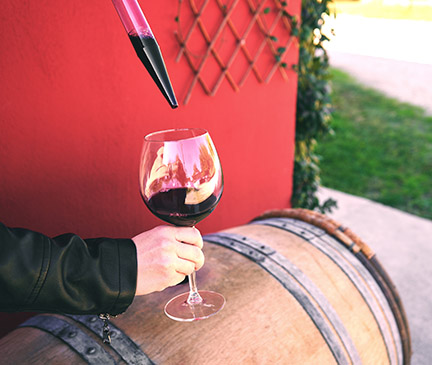
Conclusion
Obviously there are myriad decisions to make that will impact a red wine’s quality during the harvest, winemaking, and aging. Getting through all of these options required us to be as simple and uncomplicated as possible.
So consider this article as an introduction to these concepts and arguments, a surface barely scratched, a primary education at best. Spending some time with the video will give you quite a bit of added depth and examples in winemaking, and some of the results we’ve witnessed. As always, find your own best practices in the vineyard and the winery, don’t be afraid to tweak what goes wrong, and retain that which makes good wine.
Find more from Alex and Wes in the video they created while debating the topics in this article at https://www.youtube.com/watch?v=TTt2Iug
blZE



